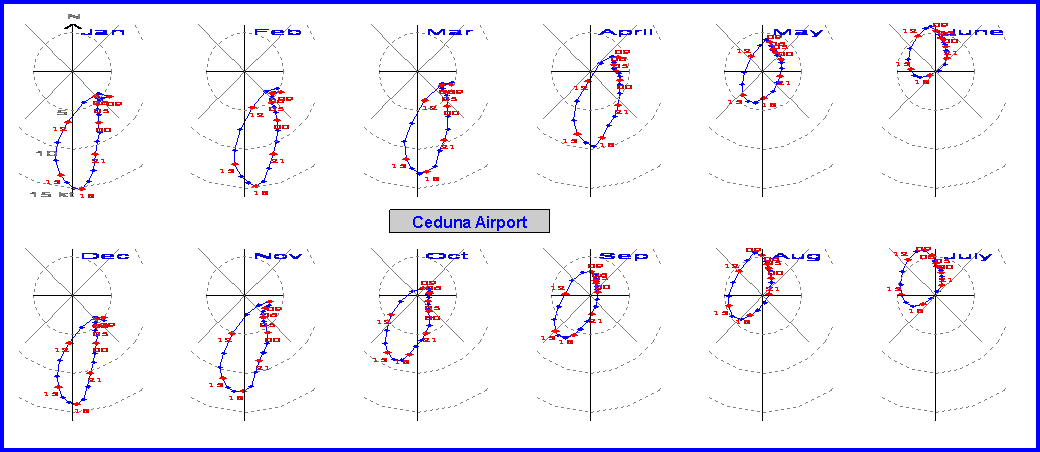|
Winds around South Australia: Climatological hourly-monthly hodographs from some representative sites. P Schwerdtfeger1, W Grace2 and B Brooks3 1 Airborne Research Australia, Adelaide SA; 2 Grace Research Network, Adelaide SA; 3 Bureau of Meteorology, Adelaide SA |


|
How to read? Eg, at Ceduna Airport in January at 1800 local time, the long-term vector mean wind is 15 knots from 170°. |
|
Data and Analysis Shown are hourly-monthly hodographs of vector mean wind from Airport sites in South Australia derived from all available half-hourly wind observations from the Bureau of Meteorology’s AWS (Automatic Weather Station) sites at the Airports of Ceduna, Woomera, Adelaide and Mount Gambier from the period May 1992 to June 2004 (see top right inset map for locations). All observations at each hour in each month were used to obtain a vector mean wind associated with a particular hour of the day and month. The half hourly observations were treated similarly. Observations from any other time were assigned to the nearest whole or half-hour. The half-hour results were combined with the whole hour results in a 1:2:1 ratio. Each hourly-monthly wind mean incorporates approximately 400 hourly and 800 half-hourly observations. The vector mean winds for each hour of each month so calculated were then plotted in hodograph style with speed rings at 5 knot increments and directions “from”. |
|
Results and Discussion The sequences of hodographs exhibit aesthetic appeal and illustrate anticipated features and some less-known features of the mean wind. To highlight the solstice-to-solstice symmetry the months are shown clockwise for each site. Late morning winds tend to align with the climatological geostrophic flow (see adjacent mslp mean charts. The early morning and overnight winds tend to be driven by local topography; the afternoon winds are clearly driven by sea breezes. Common to all is the daily anticlockwise cycling of the hodograph trace. The sea breezes of the West Coast (represented by Ceduna Airport) are seen to blow well into the evening. Sea breezes are apparent in most months for near–coast stations, such as Adelaide Airport. |